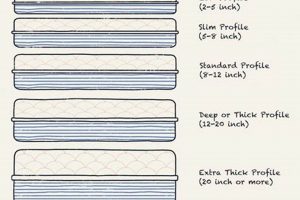The dimensions of bedding designed for medical facilities are standardized to accommodate specific patient needs and equipment. These measurements are crucial for ensuring proper fit within the bed frame and supporting therapeutic interventions. For example, a typical medical bed mattress measures approximately 36 inches wide and 80 inches long, although variations exist to accommodate bariatric or pediatric patients.
Appropriate dimensions are essential for patient comfort, safety, and effective care. Properly sized bedding prevents pressure sores by distributing weight evenly and allowing for adequate circulation. Furthermore, the standardized dimensions facilitate the use of specialized equipment, such as alternating pressure pads and lateral rotation devices, which are integral to patient recovery and rehabilitation. Historically, the standardization of these dimensions has improved the efficiency of healthcare delivery and the quality of patient outcomes.
The following sections will further examine specific dimensional variations, material considerations influencing comfort and support, and regulatory standards governing the design and manufacturing of medical-grade mattresses.
Considerations for Medical Bedding Dimensions
The following guidelines provide insight into selecting and maintaining appropriate bedding for hospital beds, ensuring optimal patient care and safety.
Tip 1: Verify Bed Frame Compatibility: Prior to selecting a mattress, confirm that the dimensions align precisely with the bed frame specifications. Incompatible sizes can compromise patient safety and diminish therapeutic effectiveness.
Tip 2: Account for Patient Specific Needs: Individual factors such as patient weight, height, and medical condition necessitate adjustments to standard dimensions. Bariatric patients, for instance, require wider and sturdier surfaces.
Tip 3: Prioritize Pressure Redistribution: Mattresses should effectively redistribute pressure to mitigate the risk of pressure ulcer development. Assess the composition and design for optimal pressure relief capabilities.
Tip 4: Assess Material Durability and Cleanability: Medical environments demand materials capable of withstanding frequent cleaning and disinfection. Select mattresses constructed from fluid-resistant and antimicrobial materials.
Tip 5: Ensure Compliance with Regulatory Standards: Bedding should adhere to all relevant regulatory standards and safety guidelines. Verify certifications related to flammability, infection control, and patient safety.
Tip 6: Establish a Regular Maintenance Schedule: Implement a routine inspection and maintenance program to identify and address any signs of wear, damage, or contamination. Timely repairs or replacements are crucial for maintaining hygiene and functionality.
Adhering to these considerations contributes to a safe, comfortable, and therapeutic environment for patients requiring hospital bed care.
The subsequent sections will explore the long-term economic implications of proper mattress selection and the role of technological advancements in enhancing mattress design and functionality.
1. Standard Width (36 inches)
The standard width of 36 inches for a hospital bed mattress is a foundational element in healthcare facility design and patient care. It dictates compatibility with medical equipment, influences patient comfort, and directly impacts caregiver efficiency.
- Equipment Integration
The 36-inch width facilitates seamless integration of medical devices. Items such as side rails, overbed tables, and patient lifts are designed to work within this dimension, ensuring safe and efficient utilization. Deviations from this standard could compromise equipment functionality and patient safety.
- Caregiver Accessibility
This dimension allows caregivers adequate space to maneuver around the bed, providing direct access for patient care. Tasks such as repositioning, wound care, and administering medication are streamlined by the accessibility afforded by the 36-inch width. Wider mattresses can impede caregiver movement and increase the risk of injury.
- Patient Comfort and Positioning
While relatively narrow compared to residential mattresses, the 36-inch width allows for therapeutic positioning and pressure redistribution strategies. Specialized mattresses utilizing advanced materials and zoning techniques maximize comfort and minimize pressure points within this dimension. Proper pressure management is crucial in preventing pressure ulcers.
- Cost Efficiency and Standardization
The standardization of the 36-inch width allows for economies of scale in mattress manufacturing and hospital bed frame production. This reduces costs and simplifies inventory management. The universality of the size also enables hospitals to easily transfer mattresses between beds, increasing efficiency.
In summary, the 36-inch standard width is a carefully considered dimension integral to the overall design and functionality of hospital beds. It balances patient comfort, caregiver accessibility, equipment compatibility, and cost considerations to deliver safe and effective healthcare.
2. Standard Length (80 inches)
The standard length of 80 inches is a critical component of the overall dimensions defining a hospital bed mattress. This measurement directly impacts patient comfort, postural support, and the efficacy of therapeutic interventions. An insufficient length can lead to discomfort, compromised spinal alignment, and increased risk of pressure ulcer formation, especially in taller patients. Conversely, a length exceeding 80 inches, while potentially accommodating, may create challenges in smaller rooms or complicate the use of certain assistive devices. Real-world examples in rehabilitation settings demonstrate the importance of proper bed length; patients undergoing physical therapy often require specific positioning, which is facilitated by the appropriate bed dimensions. Consequently, the 80-inch standard seeks to provide optimal support for a diverse patient population, balancing comfort and practical considerations.
Further analysis reveals the practical applications of adhering to the 80-inch standard. Hospital bed manufacturers design frames and accessories around this dimension, ensuring compatibility with a wide range of medical equipment. For instance, electronic health record documentation systems often integrate measurements of bed dimensions to accurately track patient positioning and treatment progress. Moreover, clinical guidelines for pressure ulcer prevention often specify the use of appropriately sized mattresses as a core component of care. Deviations f
rom the standard length can therefore lead to inefficiencies in workflow, increased costs associated with specialized equipment, and potential compromise of patient safety.
In summary, the 80-inch standard length serves as a fundamental parameter in defining the size of a hospital bed mattress, directly influencing patient comfort, treatment efficacy, and healthcare operational efficiency. Challenges exist in accommodating the needs of exceptionally tall individuals, but adherence to this standard promotes standardization and compatibility within the broader healthcare ecosystem. Understanding the practical significance of this dimension is therefore crucial for healthcare professionals and facility managers alike, ensuring the delivery of optimal patient care within resource constraints.
3. Bariatric Options (wider)
The availability of bariatric options within the spectrum of hospital bed mattress dimensions directly addresses the needs of patients with a body mass index (BMI) exceeding 30 kg/m. Standard hospital mattresses, typically 36 inches in width, may prove inadequate for this patient population, leading to compromised comfort, increased risk of pressure injuries, and difficulties in positioning and mobilization. Wider mattresses, often ranging from 42 to 48 inches, offer an expanded surface area to distribute weight more effectively, reducing pressure points and enhancing circulatory support. In critical care units, the implementation of bariatric-specific mattresses has been shown to decrease the incidence of pressure ulcers among obese patients, highlighting the direct correlation between mattress width and patient outcomes.
Further analysis reveals that the adoption of bariatric mattress options necessitates adjustments to bed frame design, weight capacity ratings, and facility infrastructure. Bariatric beds must support significantly higher loads, requiring reinforced frames and durable materials. Staff training is also essential to ensure the safe operation of these specialized beds and to facilitate proper patient handling techniques. Hospitals must also consider the economic implications of investing in bariatric equipment, weighing the initial costs against the potential reduction in pressure ulcer treatment expenses and improved patient satisfaction scores. The procurement process should include thorough evaluation of mattress material composition, pressure redistribution capabilities, and compliance with relevant safety standards. For example, mattresses utilizing advanced foam technology and zone-based construction offer superior pressure relief compared to traditional innerspring designs.
In summary, the provision of wider bariatric options within the overall selection of hospital bed mattress dimensions constitutes a crucial component of comprehensive patient care. These specialized mattresses mitigate risks associated with obesity, enhance patient comfort, and improve healthcare outcomes. While challenges remain in terms of infrastructure investment and staff training, the benefits of accommodating bariatric patients with appropriately sized bedding are undeniable, underscoring the ethical and practical imperative for hospitals to prioritize these resources. The increasing prevalence of obesity necessitates a proactive approach to healthcare design, with bariatric considerations integrated into facility planning and equipment procurement strategies.
4. Pediatric Dimensions (smaller)
The application of smaller dimensions in hospital bed mattresses for pediatric patients represents a critical adaptation of standard medical equipment to meet the unique physiological and developmental needs of children. These adjustments are not merely scaled-down versions of adult beds, but rather carefully engineered surfaces designed to promote safety, comfort, and effective therapeutic intervention.
- Enhanced Safety Measures
Reduced mattress dimensions are often coupled with increased side rail height and gap minimization to prevent falls and entrapment, which are significant concerns in pediatric care. Smaller bed sizes facilitate closer monitoring of patients by nursing staff, enabling quicker response to emergent situations. For example, neonatal intensive care units (NICUs) utilize specialized cribs and mattresses with specific safety features tailored to premature infants.
- Optimized Postural Support
Pediatric patients require different levels of support compared to adults due to their developing musculoskeletal systems. Smaller mattresses can be designed with varying densities and support zones to accommodate these needs, ensuring proper spinal alignment and minimizing pressure points. In children with neuromuscular disorders, customized mattresses may be necessary to prevent deformities and promote optimal positioning.
- Improved Thermal Regulation
Infants and young children have less developed thermoregulatory systems, making them more susceptible to temperature fluctuations. Smaller mattresses can be integrated with warming or cooling devices to maintain a stable thermal environment, particularly in neonatal settings. The selection of mattress materials also plays a role in heat retention and breathability, influencing patient comfort and minimizing the risk of hypothermia or hyperthermia.
- Facilitated Access for Procedures
Smaller mattress dimensions improve caregiver access during medical procedures, such as intubation, central line placement, and surgical interventions. The reduced size allows for better visualization and maneuverability, enhancing the precision and efficiency of these procedures. Specialized mattresses may also incorporate features like cutouts or adjustable sections to further facilitate access to specific anatomical regions.
The careful consideration of pediatric dimensions in hospital bed mattresses underscores the importance of age-specific design in healthcare. These adjustments not only enhance patient safety and comfort but also contribute to the overall efficacy of medical interventions. While standard dimensions serve a purpose for the general adult population, specialized dimensions are necessary to accommodate the unique needs of vulnerable pediatric patients, optimizing their care and promoting positive health outcomes.
5. Thickness and Support
The correlation between mattress thickness and support is a fundamental aspect of hospital bed design, directly impacting patient comfort, pressure redistribution, and overall therapeutic efficacy. Within the broader context of “size of a hospital bed mattress,” thickness serves as a critical determinant of the support a mattress can provide. A thicker mattress, constructed with appropriate internal materials, generally offers superior pressure relief and spinal alignment compared to a thinner counterpart. For instance, a mattress with a thickness of 6 inches may suffice for short-term use or low-risk patients, whereas a high-risk patient requiring prolonged bed rest necessitates a mattress with a thickness of at least 8 inches, incorporating multiple layers of high-density foam or air-filled chambers. Inadequate thickness
and support can lead to increased pressure on bony prominences, elevating the risk of pressure ulcer development and patient discomfort.
The composition of the mattress core and the density of materials directly influence the support characteristics, irrespective of overall dimensions. A thicker mattress utilizing low-density foam may provide minimal support, leading to patient “bottoming out,” where the patient’s weight compresses the mattress entirely, negating any pressure relief benefits. Conversely, a thinner mattress constructed with high-density viscoelastic foam can offer substantial support and pressure redistribution, albeit potentially limited in long-term performance. Hospital procurement processes typically include assessments of pressure mapping data, which quantitatively evaluate the mattress’s ability to distribute weight evenly across the contact surface. Furthermore, regulatory standards mandate minimum thickness and support requirements for hospital mattresses to ensure patient safety and prevent adverse outcomes.
In summary, thickness and support are inextricably linked components of a hospital bed mattress, influencing patient well-being and therapeutic outcomes. While overall size dictates the mattress’s fit within the bed frame, thickness determines its ability to provide adequate pressure redistribution and spinal alignment. The selection of appropriate mattress thickness should be guided by patient risk factors, clinical guidelines, and regulatory requirements, with ongoing monitoring to ensure sustained support and prevent complications. Understanding this connection is essential for healthcare professionals involved in equipment procurement and patient care, enabling informed decisions that promote optimal patient outcomes.
Frequently Asked Questions
The following addresses commonly encountered inquiries regarding dimensions of hospital bed mattresses and their impact on patient care.
Question 1: What constitutes the standard dimensions for a hospital bed mattress?
The standard dimensions typically measure 36 inches in width and 80 inches in length. These dimensions facilitate compatibility with the majority of hospital bed frames and accessories.
Question 2: Are variations in dimensions available to accommodate diverse patient populations?
Yes. Bariatric options with increased width are available for patients exceeding standard weight limits. Pediatric sizes are also produced to suit the needs of younger patients.
Question 3: How does mattress thickness influence patient support and pressure redistribution?
Thickness directly affects the mattress’s ability to distribute weight and alleviate pressure points. Thicker mattresses generally offer superior support and are recommended for patients at high risk of pressure ulcer development.
Question 4: What role do standardized dimensions play in ensuring patient safety?
Standardized dimensions ensure compatibility with safety devices such as side rails, thereby reducing the risk of falls and entrapment. Consistent dimensions also facilitate efficient patient handling by medical personnel.
Question 5: How does the selection of appropriate mattress dimensions contribute to overall patient comfort?
Appropriate dimensions promote proper spinal alignment and prevent pressure build-up, contributing to improved patient comfort and reducing the incidence of pain or discomfort during extended periods of bed rest.
Question 6: What regulatory standards govern the dimensions and construction of hospital bed mattresses?
Regulatory bodies establish standards for flammability, infection control, and patient safety. Compliance with these standards is essential to ensure that mattresses meet minimum safety and performance requirements.
In summary, appropriate selection of mattress dimensions is crucial for optimizing patient safety, comfort, and therapeutic outcomes. Healthcare facilities should carefully consider patient needs and regulatory requirements when procuring hospital bed mattresses.
The next section will explore material considerations in the construction of hospital bed mattresses.
Conclusion
The preceding sections have comprehensively addressed the significance of hospital bed mattress dimensions. From standard measurements to specialized options for bariatric and pediatric populations, the importance of appropriate sizing has been emphasized. Mattress thickness and its direct correlation to patient support and pressure redistribution were also explored, underscoring the need for informed procurement decisions. The dimensions influence patient safety, comfort, and the efficacy of medical interventions.
The precise measurement of hospital bed mattresses extends beyond mere convenience. It is a critical factor in patient care and hospital operations. Understanding and prioritizing proper dimensions will enhance patient outcomes and optimize healthcare resource utilization. Further research and continuous improvement in design are essential to meet the evolving needs of diverse patient populations. Adherence to established standards and adaptation to specific patient requirements are crucial elements in delivering quality medical care.


![The Ultimate King Size Beds with Mattress [Guide] Organic & Natural Mattress Buyer’s Guide: Non-Toxic Sleep Solutions The Ultimate King Size Beds with Mattress [Guide] | Organic & Natural Mattress Buyer’s Guide: Non-Toxic Sleep Solutions](https://mattressworldpa.com/wp-content/uploads/2025/07/th-7104-300x200.jpg)


![Best Bed Car Mattress [Guide] Mobile Beds For Cars Organic & Natural Mattress Buyer’s Guide: Non-Toxic Sleep Solutions Best Bed Car Mattress [Guide] Mobile Beds For Cars | Organic & Natural Mattress Buyer’s Guide: Non-Toxic Sleep Solutions](https://mattressworldpa.com/wp-content/uploads/2025/07/th-7101-300x200.jpg)

